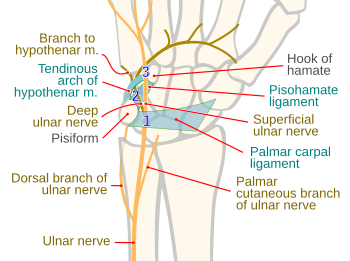Loge de Guyon syndrome
| Classification according to ICD-10 | |
|---|---|
| G56.2 | Ulnar nerve lesion |
| ICD-10 online (WHO version 2019) | |
The ulnar tunnel syndrome is an injury to the ulnar nerve on the little finger side (ulnar) of the wrist. It goes hand in hand with sensory disturbances and paralysis of the hand and finger muscles.
The Loge de Guyon is a physiological bottleneck at the wrist between the pea bone ( Os pisiforme ) and the hooked process of the hook bone ( Hamulus ossis hamati ), through which the branches of the ulnar nerve and the ulnar artery pass. The ulnar nerve splits in the area of the log into a superficial branch ( ramus superficialis ) and a deep branch ( ramus profundus ), which extends under what is often a relatively narrow muscle arcade.
The bottleneck was named after the Paris surgeon and urologist Jean Casimir Félix Guyon .
The most common cause is a ganglion in the area of the Guyon box, followed by work or sport-related long-lasting or repeated compressions, such as after long cycling or repeated hammering with the ball of the little finger (hypothenary). Rarely, a fracture of the hook process or other adjacent bones can also be the cause; there are also other extremely rare causes such as arterial aneurysms, thromboses, tumors, anatomical variants and the like. a.
clinic
Typically, prolonged external pressure, for example crutches (crutch paralysis) or the handlebar grips on days of bike or motorcycle tours (bicycle paralysis), damage the terminal branch of the ulnar nerve. Due to the fixation in the Loge de Guyon , the latter cannot evade the oppression. The first symptoms of a lesion are tingling sensations ( paresthesia ) of the little finger and the ring finger (here only the ulnar (the flexor side of the hand facing the little finger)). The fully developed clinical picture also includes a muscular weakness ( paresis ) for the spreading of the fingers and for the bringing together of the fingers ( musculi interossei ).
According to Gross and Gelbermann, three types are defined depending on the level of nerve compression in the area of the Guyon lodge:
- Type I with damage to the sensory and motor parts and corresponding damage in the proximal area of the lodge before the nerve was divided into its two branches.
- Type II with purely motor failures of the internal hand muscles and corresponding damage to the deep branch ( ramus profundus ) distal to the nerve branching.
- Type III with sensitive disorders and paralysis of the palmaris brevis muscle due to damage to the superficial branch ( ramus superficialis ).
diagnosis
For the detection of a Loge de Guyon syndrome, the isolated damage to the terminal branch of the ulnar nerve ( Ramus profundus nervi ulnaris ), which curves in the palm of the hand towards the ball of the thumb, must be proven. The detection is carried out electrophysiologically . For this purpose, by means of electroneurography the conduction time between a trigger point of the ulnar nerve just above the wrist and the electrically measured muscle contraction in the superficial ramus supplied muscle (little finger ball muscle = abductor digiti minimi ) compared to a from the deep branch supplied muscle (first interosseous muscle = musculus interosseus dorsalis primus ). If the latter time is longer in absolute terms and / or in side-by-side comparison, the damage is proven.
Differential diagnosis
therapy
If the cause is external pressure, as is the case with cyclists, it is usually sufficient to remove the damaging stimulus. The nerve then usually recovers spontaneously (which can take a few weeks), since its continuity is not interrupted (so there is a neurapraxia or at most an axonotmesis ). Surgical decompression is rarely necessary if there is an external cause, but is almost always necessary if the compression is caused by a ganglion or other anatomical constriction (internal cause).
Prevention
Choosing a racing bike handlebar that allows you to grip in different hand positions and the use of padded gloves reduce the mechanical pressure effect. Usually these preventive measures are sufficient.
Web links
Individual evidence
- ↑ B. Weigel, M. Nerlich: Praxisbuch Unfallchirurgie . Springer-Verlag, Berlin 2005, ISBN 3-540-41115-1 .
- ↑ MS Gross, RH Gelbermann: The anatomy of the distal ulnar tunnel. In: Chir Orthop Rel Res. 1985; 196, pp. 238-246.
